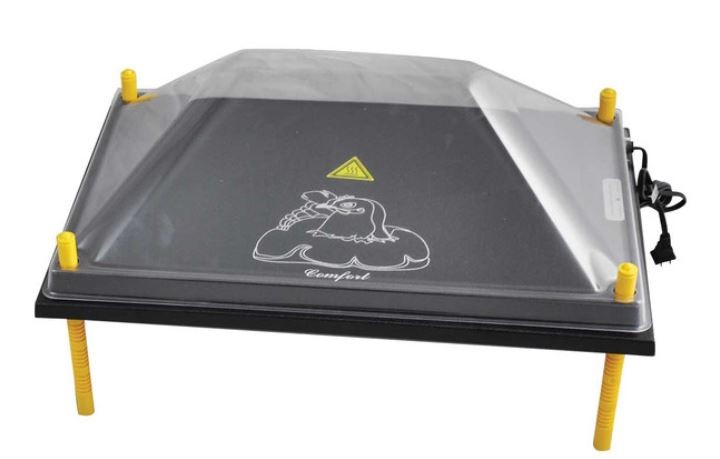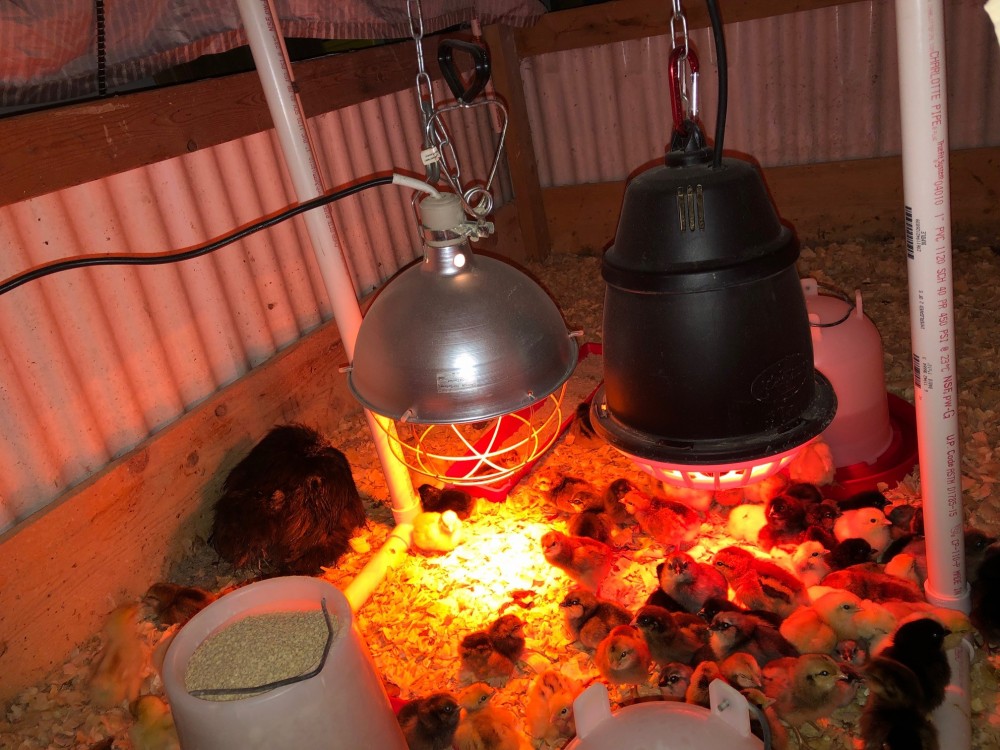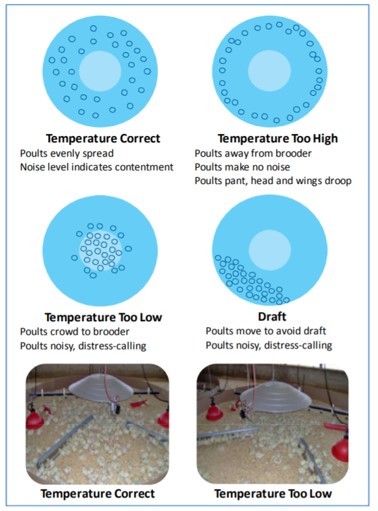Chick Brooding 101
Amy Barkley, Livestock Specialist
Southwest New York Dairy, Livestock and Field Crops Program
The weather may be cold and blustery, but it's getting to be that time where we turn our thoughts to brooding chicks for the upcoming season. Brooding chicks doesn't take much effort, but we need to make sure that we're providing the correct environment to avoid stunting or failure of the flock. This article outlines temperature, airflow, feed, and water requirements for successful brooding.
Temperature
In nature, chicks are brooded by their mothers, which have a body temperature of 106°F. The chicks huddle against her brood patch, which the hen has plucked specifically for this purpose. The radiant heat from the hen's skin warms the chicks, and as they need, they'll venture into the world for feed and water. Over time, they'll acclimate to the environment and no longer need to be brooded. Since most of us raise chicks without a mother hen, we need to mimic this environment. The two heating options available to small producers are brooder plates and brooder lights.
The plates are wide, flat, and plastic-covered, heating up to temperatures around 125°F. They radiate heat into the space underneath them, and the chicks go in this space to keep warm. As the chicks age, the plate's height is increased to lower the temperature underneath and to provide enough room for the growing biddies to fit. These present the safest option for farmers as there is very little chance of fire if the plate happens to come in contact with chicks or bedding.
 Heat plates come in a variety of styles. Photo from Stromberg's. Click to Enlarge
Heat plates come in a variety of styles. Photo from Stromberg's. Click to EnlargeHeat lamps come in a variety of styles, but for the most part are designed as a cupped base with a 250W lightbulb inside. They heat up to a hotter temperature than brood plates, warming the environment as well as the area directly underneath them. The bulbs can be white or red, with red being preferred because it will limit aggression and pecking amongst the chicks.
Safety is an important consideration with heat lamps. The image below illustrates two styles with the least safe on the left and safest on the right. The safest styles have a study cord, a fully recessed bulb, a wire or plastic cage around the bulb to lessen the risk of fire, and a point from which the lamp can be held by a chain.
 Two styles of heat lamps are shown here with the least expensive and riskiest on the left and the most expensive and safest on the right. Photo by Amy Barkley. Click to enlarge
Two styles of heat lamps are shown here with the least expensive and riskiest on the left and the most expensive and safest on the right. Photo by Amy Barkley. Click to enlarge
Regardless, brooder plates and lamps should be turned on 24 hours prior to the chicks' arrival. This will allow enough time for the environment to get nice and warm for them. When moving the chicks into the brooder, you may have to place some under the heat source to show them where to find it, just as you would dip their beaks into food and water.
The temperature of the brooder floor directly under the heat lamp should be 95°F to start. Each week, this temperature can be decreased by 5°F to begin to acclimate them to room temperature. Decreasing the temperature is as easy as adjusting the height of the lamp or heat plate. Once the chicks are fully feathered at around 6 weeks, you can start acclimating them to the outdoors.
Airflow
Airflow is very important for young chicks, but too much can be disastrous. There should be an ample amount of fresh air movement into and around the brooder. However, be wary of drafts. Chicks typically huddle away from a draft, which can result in piling and smothering. The image below shows what the ideal disbursement of chicks in a brooder should be, with an illustration of a drafty brooder in the right middle. If your brooder is susceptible to drafts, it's a good idea to round off the corners with pieces of cardboard to reduce the effects of piling.
 This diagram series from Aviagen Turkeys shows the dispersion of young poultry under a heat source. Click to enlarge
This diagram series from Aviagen Turkeys shows the dispersion of young poultry under a heat source. Click to enlarge
Feed
Feed for chicks should be a nutritionally complete starter or starter/grower formulation. This is usually around 20 - 22% protein for chicks, and closer to 26% for gamebirds like turkeys. The particles of the feed should be the size that will fit in a chicks' beaks; either a mash or crumble feed is appropriate for chicks for their first 8 weeks of life.
Many farmers wonder if they should provide a medicated feed for their poultry. Medicated feed has a low dose of a coccidiostat, typically Amprolium, for the management of coccidiosis. If your brooder tends to be on the warm and damp side, it's a good idea to feed medicated feed for the first 8 weeks of life to allow the chicks to build a natural resistance to the parasite without becoming overwhelmed by it and developing clinical symptoms.
Water
When the chicks first arrive, providing them warm water is a must. Make sure that the water isn't too hot. It should be about 95°F - 100°F. The addition of water-soluble poultry vitamins/electrolytes can help the chicks overcome shipping/hatching stress. Water is best supplied in drinkers that only allow the chicks access to a small surface area. If a bowl of water is provided, it's possible for the chicks to get in it and be chilled or possible drown.
Raising chicks is rewarding and exciting! By following these steps, you're sure to have success with your new additions. For more information on poultry production, you can contact Amy Barkley, Livestock and Beginning Farm Specialist at (716) 640-0844.
Upcoming Events
WEBINAR - Automated Milking Systems Efficiency: Balancing Focus on Individual Cows and System Optimization
May 8, 2024
Please join Cornell the SWNY team and MSU Extension for our talk with Dr. Pablo Silva Boloña on improving efficiency of Automated milking systems by focusing on milking settings for individual and group success.
Broiler Field Day at Sunny Cove Farm
June 6, 2024
Alfred Station, NY
Join us for a field day to explore broiler production, processing, and finances. Meghan Snyder of Sunny Cove Farm will be our host. She raises small batches of organic broilers, processing them on-farm under the 1,000 bird exemption.
Stockmanship and Stewardship 2024
October 25, 2024
Hamburg, NY
Save the date!! The event is one of 4 across the US and is a two-day educational experience featuring low-stress cattle handling demonstrations, Beef Quality Assurance educational sessions, facility design sessions, and industry updates.
Announcements
No announcements at this time.





